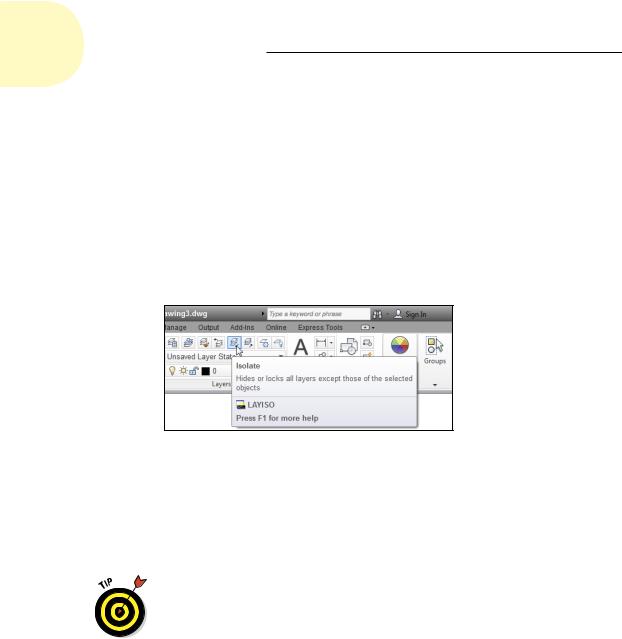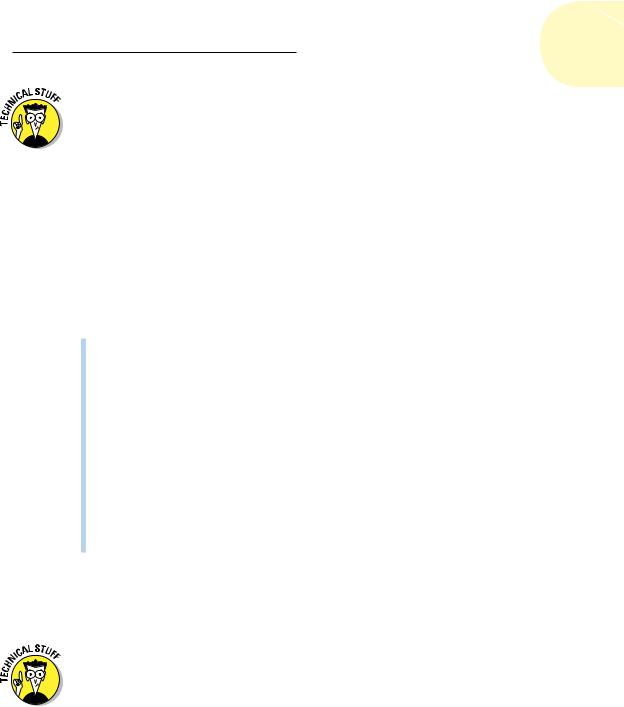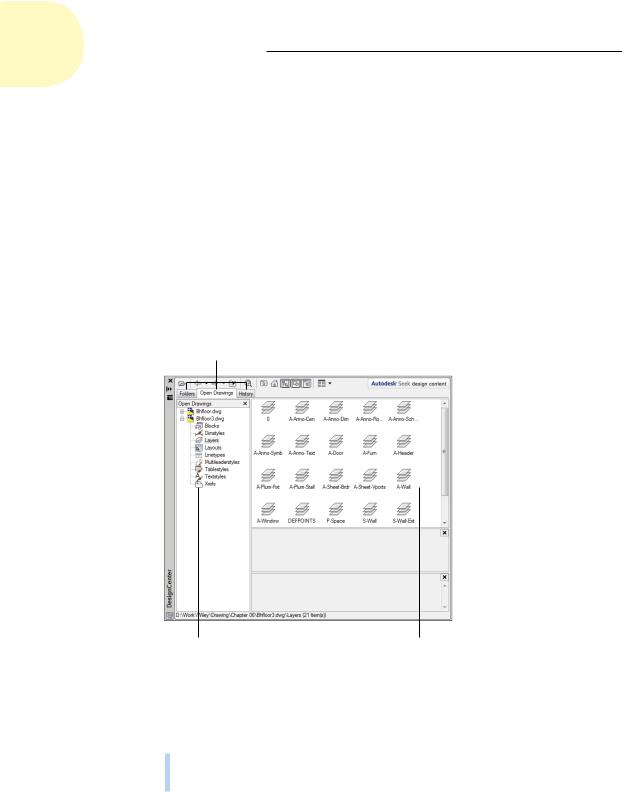
- •About the Authors
- •Dedication
- •Authors’ Acknowledgments
- •Table of Contents
- •Introduction
- •What’s Not (And What Is) in This Book
- •Mac attack!
- •Who Do We Think You Are?
- •How This Book Is Organized
- •Part I: AutoCAD 101
- •Part II: Let There Be Lines
- •Part III: If Drawings Could Talk
- •Part IV: Advancing with AutoCAD
- •Part V: On a 3D Spree
- •Part VI: The Part of Tens
- •But wait . . . there’s more!
- •Icons Used in This Book
- •A Few Conventions — Just in Case
- •Commanding from the keyboard
- •Tying things up with the Ribbon
- •Where to Go from Here
- •Why AutoCAD?
- •The Importance of Being DWG
- •Seeing the LT
- •Checking System Requirements
- •Suddenly, It’s 2013!
- •AutoCAD Does Windows (And Office)
- •And They’re Off: AutoCAD’s Opening Screens
- •Running with Ribbons
- •Getting with the Program
- •Looking for Mr. Status Bar
- •Let your fingers do the talking: The command window
- •The key(board) to AutoCAD success
- •Keeping tabs on palettes
- •Down the main stretch: The drawing area
- •Fun with F1
- •A Simple Setup
- •Drawing a (Base) Plate
- •Drawing rectangles on the right layers
- •Circling your plate
- •Nuts to you
- •Getting a Closer Look with Zoom and Pan
- •Modifying to Make It Merrier
- •Hip-hip-array!
- •Stretching out
- •Crossing your hatches
- •Following the Plot
- •A Setup Roadmap
- •Choosing your units
- •Weighing up your scales
- •Thinking annotatively
- •Thinking about paper
- •Defending your border
- •A Template for Success
- •Making the Most of Model Space
- •Setting your units
- •Making the drawing area snap-py (and grid-dy)
- •Setting linetype and dimension scales
- •Entering drawing properties
- •Making Templates Your Own
- •Setting Up a Layout in Paper Space
- •Will that be tabs or buttons?
- •View layouts Quick(View)ly
- •Creating a layout
- •Copying and changing layouts
- •Lost in paper space
- •Spaced out
- •A view(port) for drawing in
- •About Paper Space Layouts and Plotting
- •Managing Your Properties
- •Layer one on me!
- •Accumulating properties
- •Creating new layers
- •Manipulating layers
- •Using Named Objects
- •Using AutoCAD DesignCenter
- •Copying layers between drawings
- •Controlling Your Precision
- •Keyboard capers: Coordinate input
- •Understanding AutoCAD’s coordinate systems
- •Grab an object and make it snappy
- •Other Practical Precision Procedures
- •Introducing the AutoCAD Drawing Commands
- •The Straight and Narrow: Lines, Polylines, and Polygons
- •Toeing the line
- •Connecting the lines with polyline
- •Squaring off with rectangles
- •Choosing your sides with polygon
- •(Throwing) Curves
- •Going full circle
- •Arc-y-ology
- •Solar ellipses
- •Splines: The sketchy, sinuous curves
- •Donuts: The circles with a difference
- •Revision clouds on the horizon
- •Scoring Points
- •Commanding and Selecting
- •Command-first editing
- •Selection-first editing
- •Direct object manipulation
- •Choosing an editing style
- •Grab It
- •One-by-one selection
- •Selection boxes left and right
- •Perfecting Selecting
- •AutoCAD Groupies
- •Object Selection: Now You See It . . .
- •Get a Grip
- •About grips
- •A gripping example
- •Move it!
- •Copy, or a kinder, gentler Move
- •A warm-up stretch
- •Your AutoCAD Toolkit
- •The Big Three: Move, Copy, and Stretch
- •Base points and displacements
- •Move
- •Copy
- •Copy between drawings
- •Stretch
- •More Manipulations
- •Mirror
- •Rotate
- •Scale
- •Array
- •Offset
- •Slicing, Dicing, and Splicing
- •Trim and Extend
- •Break
- •Fillet and Chamfer and Blend
- •Join
- •When Editing Goes Bad
- •Zoom and Pan with Glass and Hand
- •The wheel deal
- •Navigating your drawing
- •Controlling your cube
- •Time to zoom
- •A View by Any Other Name . . .
- •Looking Around in Layout Land
- •Degenerating and Regenerating
- •Getting Ready to Write
- •Simply stylish text
- •Taking your text to new heights
- •One line or two?
- •Your text will be justified
- •Using the Same Old Line
- •Turning On Your Annotative Objects
- •Saying More in Multiline Text
- •Making it with Mtext
- •It slices; it dices . . .
- •Doing a number on your Mtext lists
- •Line up in columns — now!
- •Modifying Mtext
- •Gather Round the Tables
- •Tables have style, too
- •Creating and editing tables
- •Take Me to Your Leader
- •Electing a leader
- •Multi options for multileaders
- •How Do You Measure Up?
- •A Field Guide to Dimensions
- •The lazy drafter jumps over to the quick dimension commands
- •Dimension associativity
- •Where, oh where, do my dimensions go?
- •The Latest Styles in Dimensioning
- •Creating and managing dimension styles
- •Let’s get stylish!
- •Adjusting style settings
- •Size Matters
- •Details at other scales
- •Editing Dimensions
- •Editing dimension geometry
- •Editing dimension text
- •Controlling and editing dimension associativity
- •Batten Down the Hatches!
- •Don’t Count Your Hatches. . .
- •Size Matters!
- •We can do this the hard way. . .
- •. . . or we can do this the easy way
- •Annotative versus non-annotative
- •Pushing the Boundary (Of) Hatch
- •Your hatching has no style!
- •Hatch from scratch
- •Editing Hatch Objects
- •You Say Printing, We Say Plotting
- •The Plot Quickens
- •Plotting success in 16 steps
- •Get with the system
- •Configure it out
- •Preview one, two
- •Instead of fit, scale it
- •Plotting the Layout of the Land
- •Plotting Lineweights and Colors
- •Plotting with style
- •Plotting through thick and thin
- •Plotting in color
- •It’s a (Page) Setup!
- •Continuing the Plot Dialog
- •The Plot Sickens
- •Rocking with Blocks
- •Creating Block Definitions
- •Inserting Blocks
- •Attributes: Fill-in-the-Blank Blocks
- •Creating attribute definitions
- •Defining blocks that contain attribute definitions
- •Inserting blocks that contain attribute definitions
- •Edit attribute values
- •Extracting data
- •Exploding Blocks
- •Purging Unused Block Definitions
- •Arraying Associatively
- •Comparing the old and new ARRAY commands
- •Hip, hip, array!
- •Associatively editing
- •Going External
- •Becoming attached to your xrefs
- •Layer-palooza
- •Creating and editing an external reference file
- •Forging an xref path
- •Managing xrefs
- •Blocks, Xrefs, and Drawing Organization
- •Mastering the Raster
- •Attaching a raster image
- •Maintaining your image
- •Theme and Variations: Dynamic Blocks
- •Lights! Parameters!! Actions!!!
- •Manipulating dynamic blocks
- •Maintaining Design Intent
- •Defining terms
- •Forget about drawing with precision!
- •Constrain yourself
- •Understanding Geometric Constraints
- •Applying a little more constraint
- •AutoConstrain yourself!
- •Understanding Dimensional Constraints
- •Practice a little constraint
- •Making your drawing even smarter
- •Using the Parameters Manager
- •Dimensions or constraints — have it both ways!
- •The Internet and AutoCAD: An Overview
- •You send me
- •Send it with eTransmit
- •Rapid eTransmit
- •Bad reception?
- •Help from the Reference Manager
- •Design Web Format — Not Just for the Web
- •All about DWF and DWFx
- •Autodesk Design Review 2013
- •The Drawing Protection Racket
- •Autodesk Weather Forecast: Increasing Cloud
- •Working Solidly in the Cloud
- •Free AutoCAD!
- •Going once, going twice, going 123D
- •Your head planted firmly in the cloud
- •The pros
- •The cons
- •Cloudy with a shower of DWGs
- •AutoCAD 2013 cloud connectivity
- •Tomorrow’s Forecast
- •Understanding 3D Digital Models
- •Tools of the Trade
- •Warp speed ahead
- •Entering the third dimension
- •Untying the Ribbon and opening some palettes
- •Modeling from Above
- •Using 3D coordinate input
- •Using point filters
- •Object snaps and object snap tracking
- •Changing Planes
- •Displaying the UCS icon
- •Adjusting the UCS
- •Navigating the 3D Waters
- •Orbit à go-go
- •Taking a spin around the cube
- •Grabbing the SteeringWheels
- •Visualizing 3D Objects
- •Getting Your 3D Bearings
- •Creating a better 3D template
- •Seeing the world from new viewpoints
- •From Drawing to Modeling in 3D
- •Drawing basic 3D objects
- •Gaining a solid foundation
- •Drawing solid primitives
- •Adding the Third Dimension to 2D Objects
- •Creating 3D objects from 2D drawings
- •Modifying 3D Objects
- •Selecting subobjects
- •Working with gizmos
- •More 3D variants of 2D commands
- •Editing solids
- •Get the 2D Out of Here!
- •A different point of view
- •But wait! There’s more!
- •But wait! There’s less!
- •Do You See What I See?
- •Visualizing the Digital World
- •Adding Lighting
- •Default lighting
- •User-defined lights
- •Sunlight
- •Creating and Applying Materials
- •Defining a Background
- •Rendering a 3D Model
- •Autodesk Feedback Community
- •Autodesk Discussion Groups
- •Autodesk’s Own Bloggers
- •Autodesk University
- •The Autodesk Channel on YouTube
- •The World Wide (CAD) Web
- •Your Local ATC
- •Your Local User Group
- •AUGI
- •Books
- •Price
- •3D Abilities
- •Customization Options
- •Network Licensing
- •Express Tools
- •Parametrics
- •Standards Checking
- •Data Extraction
- •MLINE versus DLINE
- •Profiles
- •Reference Manager
- •And The Good News Is . . .
- •APERTURE
- •DIMASSOC
- •MENUBAR
- •MIRRTEXT
- •OSNAPZ
- •PICKBOX
- •REMEMBERFOLDERS
- •ROLLOVERTIPS
- •TOOLTIPS
- •VISRETAIN
- •And the Bonus Round
- •Index

140 Part II: Let There Be Lines
criteria that you define (for example, all layers whose names contain Wall or whose color is green). To find out more, move your mouse pointer into the Layer Properties Manager palette, press F1, and click the New Property Filter hyperlink.
In both AutoCAD and AutoCAD LT, you can access a set of layer tools through the Layers panel of the Ribbon’s Home tab — see Figure 6-10. (You may have to open the panel slideout to see them all.) Layer Isolate and Layer Off are especially useful — you simply click an object to specify the layer to isolate (that is, fade all layers except the chosen one) or turn off altogether. For more information on layers, open the online help system and choose User’s Guide Create and Modify Objects Control the Properties of Objects Work with Layers Use Layers to Manage Complexity.
Figure 6-10: Tooling through the layer tools.
The LAYISO command incorporates the same layer-fading feature described in the preceding tip for locked layers — and it locks the layers as well. Set it up the way you want by typing S (for Settings) and pressing Enter; then type the option letter for the specific settings you want. Look up LAYISO in the online help Index for more information.
Instead of turning off a layer when there are only a few things in the way, you can hide or isolate individual objects with the ISOLATEOBJECTS and HIDEOBJECTS commands while keeping normal visibility for other objects on the layer. We discuss these commands in Chapter 10.
Using Named Objects
One of the things that can make AutoCAD a tough nut to crack is the somewhat cavalier naming conventions used in the program’s documentation. For years, things like lines, arcs, and other graphical items were called entities, but then more recently, they started being called objects. Fair enough, but object has also long been used to define certain nongraphical components of a drawing — things that you’d hardly consider to be objects at all — and those are the kind of “named objects” we describe in what follows.
www.it-ebooks.info

Chapter 6: Manage Your Properties 141
Hidden in the innards of every AutoCAD drawing file is a set of named objects, which are organized into symbol tables, and the properties that are common to all AutoCAD objects are defined in these tables. For example, all the line objects in a drawing are stored on one or more layers, so a layer property is common to all lines and is defined in the layer table. But the coordinates that define the start and end points of a given line are unique to that line (or they should be!) — so the coordinate properties are not common to all lines.
A layer is one example of a named object. The layer table in a given drawing contains a list of the layers in the current drawing, along with the settings for each layer (including color, linetype, on/off setting, and so on).
Named objects don’t appear as graphical objects in your drawing. They’re like the hardworking pit crew that keeps the race cars running smoothly behind the scenes. The named objects you’re likely to use the most include the following:
Layers (covered in the section “Layer one on me!,” earlier in this chapter)
Linetypes (covered in the section “Accumulating properties,” earlier in this chapter)
Text styles (See Chapter 13.)
Table styles (See Chapter 13.)
Multileader styles (See Chapter 13.)
Multiline styles (not covered in this book; see the online help)
Dimension styles (See Chapter 14.)
Block definitions and xrefs (See Chapters 17 and 18.)
Layouts (See Chapter 5.)
When you use commands such as LAYER, LINETYPE, and DIMSTYLE you’re creating and editing named objects. After you’ve created named objects in a drawing, AutoCAD DesignCenter or Content Explorer give you the tools to copy them between drawings.
Donald Trump might think otherwise, but you can have too many properties (at least in AutoCAD). You may have created layers or loaded linetypes, text, or dimension styles that you end up not using. If you think that you may have some of these superfluous named objects in your drawing, the PURGE command helps you get rid of them. Click the Application button to display the Application Menu. Choose Drawing Utilities, and then Purge to open the Purge dialog box. You can click the plus sign (+) beside each category to purge individual items, or you can click Purge All and get rid of tons of stuff at once. Visit the online help for more about purging.
www.it-ebooks.info

142 Part II: Let There Be Lines
Using AutoCAD DesignCenter
DesignCenter is a dumb name for a useful, if somewhat busy, palette. (At least they didn’t call it DesignCenter Manager!) The DesignCenter palette is handy for borrowing data from other drawings. Whereas the Properties palette (described in the section “Managing Your Properties,” earlier in this
chapter) is concerned with properties of graphical objects, the DesignCenter palette deals primarily with named objects: layers, linetypes, block definitions, text styles, and other organizational objects in drawings.
The DesignCenter palette (shown in Figure 6-11) consists of a toolbar at the top, a set of three tabs below that, a tree view pane on the left, and a content pane on the right. The tree view pane displays a Windows Explorer–like navigation panel, showing drawing files and the symbol tables contained in each drawing. The content pane usually displays the contents of the selected drawing or symbol table.
Tabs
Tree view pane Content pane
Figure 6-11: The AutoCAD DesignCenter palette.
The three tabs just below the DesignCenter toolbar control what you see in the tree view and content panes:
Folders: This tab shows the folders on your local and network drives, just like the Windows Explorer Folders pane does. Use this tab if the drawing you want to copy from isn’t currently open in AutoCAD.
www.it-ebooks.info

Chapter 6: Manage Your Properties 143
Open Drawings: This tab (current in Figure 6-11) shows the drawings that are currently open in AutoCAD. Use this tab to copy named objects between open drawings.
History: This tab shows drawings that you’ve recently browsed in DesignCenter. Use this tab to jump quickly to drawings that you’ve used recently on the Folders tab.
The Autodesk Seek Design Content button on DesignCenter’s toolbar links to parts libraries that are available on Autodesk’s website. (Seek is also accessible through the Content Explorer, which we introduce you to in Chapters 1 and 2.) Autodesk Seek is essentially an online catalog of drawings of building products, like doors and bolts. Browse the offerings to see whether any of the online libraries can be useful in your work.
The toolbar buttons further refine what you see in the tree view and content panes. A few of these buttons toggle different parts of the panes.
The following steps outline the procedure for using DesignCenter to copy named objects from one drawing to another. See the next section for a specific example.
1.If it isn’t already open, switch to the Ribbon’s View tab, find the Palettes panel, and click DesignCenter to open the DesignCenter palette.
You can also press Ctrl+2 to open this palette.
2.Select or load the drawing(s) whose content you want to view or use into the navigation pane on the left.
If the source drawing is already open, you can access its content from the Open Drawings tab. If the source drawing isn’t open but is stored on your hard drive or network, click Load on the DesignCenter toolbar and navigate to the file’s location in the Folders tab.
3.In the Open Drawings tab (if the source drawing is currently open) or the Folders tab (if the source drawing isn’t open) of the tree view pane, click the plus sign (+) beside the source file to expand the list of named object categories.
The named object categories appear in a list in the tree view pane on the left and as icons in the content pane on the right.
4.In the tree view pane, select the category of named object you want to copy.
The content pane now displays the individual named objects within the named object category. For example, in Figure 6-11 (shown previously), the Layers category is selected in the tree view pane, and icons for each named layer are shown in the content pane.
www.it-ebooks.info
